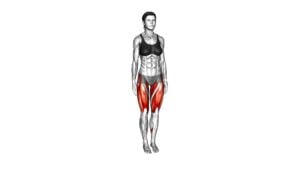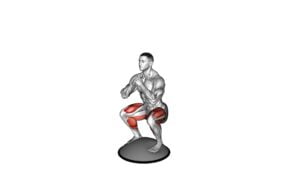Bosu Ball Alternate Heel Touch Side Kick Squat – Video Exercise Guide & Tips

Are you looking for a challenging exercise to improve your balance and stability? Look no further than the Bosu Ball Alternate Heel Touch Side Kick Squat.
Watch This Exercise Video
This video exercise guide and tips article will show you how to perform this exercise correctly and efficiently. With proper form and technique, you can reap the benefits of this exercise, including strengthening your legs and core muscles.
Watch the video and follow the tips to take your workout to the next level.
Key Takeaways
- The Bosu Ball Alternate Heel Touch Side Kick Squat strengthens legs and core muscles.
- It helps prevent injuries and improves lower body strength.
- This exercise provides stability to knees and ankles and activates multiple muscle groups simultaneously.
- Proper form and technique, as well as maintaining balance and stability, are crucial for maximizing the effectiveness and safety of this exercise.
Benefits of the Bosu Ball Alternate Heel Touch Side Kick Squat
You can enhance your lower body strength and balance by performing the Bosu Ball Alternate Heel Touch Side Kick Squat. This exercise offers numerous benefits, including injury prevention and muscle activation.
One of the key advantages of this exercise is injury prevention. By performing the Bosu Ball Alternate Heel Touch Side Kick Squat, you engage your core muscles, which helps stabilize your body and prevent injuries. Additionally, this exercise targets the muscles in your legs, such as your quadriceps, hamstrings, and glutes, which can help improve your overall lower body strength. Strengthening these muscles can also provide added stability to your knees and ankles, reducing the risk of injury during physical activities or sports.
Furthermore, the Bosu Ball Alternate Heel Touch Side Kick Squat activates multiple muscle groups simultaneously. As you squat down on the Bosu Ball, you engage your quadriceps and hamstrings. When you perform the side kick, your glutes, hip abductors, and hip adductors come into play. This combination of muscle activation leads to a more efficient and effective workout, maximizing the benefits you can gain from this exercise.
Proper Form and Technique for the Bosu Ball Alternate Heel Touch Side Kick Squat
To perform the Bosu Ball Alternate Heel Touch Side Kick Squat with proper form and technique, follow these steps.
- Begin by standing on a Bosu ball with one foot placed in the center and the other foot lifted slightly off the ground.
- Keep your core engaged and maintain a neutral spine throughout the exercise.
- Next, lower your body into a squat position by bending at the knees and hips.
- As you squat, reach down and touch your opposite hand to your heel.
- Then, drive through the heel of your standing foot and extend your leg out to the side in a kicking motion.
- Return to the starting position and repeat the movement on the other side.
This exercise helps in improving coordination and increasing lower body strength. It challenges your balance and stability, forcing your muscles to work harder. Remember to maintain control and stability throughout the exercise to maximize its benefits.
Tips to Improve Balance and Stability During the Bosu Ball Alternate Heel Touch Side Kick Squat
To improve balance and stability during the Bosu Ball Alternate Heel Touch Side Kick Squat, focus on maintaining a strong core and engaging your muscles throughout the exercise. A strong core is essential for stability as it helps to keep your body aligned and balanced. Engaging your core muscles involves contracting them and keeping them activated throughout the entire movement. This will provide a solid foundation and enhance your balance during the exercise.
In addition to core engagement, it's important to pay attention to your body alignment. Make sure your feet are hip-width apart and your knees are in line with your toes. This will help to maintain proper balance and prevent any unnecessary strain on your joints.
To further improve your balance, try to keep your gaze focused on a fixed point in front of you. This will help to stabilize your body and prevent dizziness or loss of balance.
Lastly, take your time and focus on your breathing. Inhale as you lower your body into the squat and exhale as you perform the side kick. This will help to maintain a steady rhythm and promote better stability throughout the exercise.
Modifications and Variations for the Bosu Ball Alternate Heel Touch Side Kick Squat
One modification for the Bosu Ball Alternate Heel Touch Side Kick Squat is to incorporate the use of dumbbells to increase the intensity of the exercise. By holding dumbbells in your hands while performing the exercise, you'll add resistance and challenge your muscles even more. This modification is great for those who've already mastered the basic movement and are looking to progress further.
Another modification for this exercise is to perform the squat without the Bosu ball. This can be helpful for beginners or individuals who may not have access to a Bosu ball. Simply perform the alternate heel touch side kick squat on solid ground, focusing on maintaining proper form and control throughout the movement. As you become more comfortable and confident, you can then progress to using the Bosu ball for added instability and difficulty.
To further progress the Bosu Ball Alternate Heel Touch Side Kick Squat, you can increase the speed of the exercise. By performing the movement at a quicker pace, you'll challenge your cardiovascular system and improve your overall coordination and agility.
Remember to always listen to your body and start with modifications that suit your fitness level. As you become stronger and more comfortable, you can gradually increase the difficulty of the exercise by incorporating these modifications and progressions.
Common Mistakes to Avoid During the Bosu Ball Alternate Heel Touch Side Kick Squat
When performing the Bosu Ball Alternate Heel Touch Side Kick Squat, it's important to be aware of common mistakes to avoid. By avoiding these mistakes, you can ensure proper form and maximize the effectiveness of the exercise.
One common mistake isn't maintaining a stable core. It's important to engage your core muscles throughout the entire movement to provide stability and prevent injury. To improve, focus on contracting your abdominal muscles and keeping your spine in a neutral position.
Another mistake is leaning too far forward or backward. This can put unnecessary strain on your lower back and compromise your balance. To correct this, make sure to keep your torso upright and your weight evenly distributed between both feet.
Inadequate balance can also be a problem. If you find it difficult to stay balanced on the Bosu Ball, try starting with a stable surface and gradually progress to the Bosu Ball as your balance improves. You can also try holding onto a stable object for support until you feel more comfortable.
Lastly, rushing through the exercise without proper control can lead to poor form and reduced effectiveness. Take your time and focus on performing each movement with control and precision.
Frequently Asked Questions
How Many Calories Can I Burn by Doing the Bosu Ball Alternate Heel Touch Side Kick Squat?
You can burn calories by doing the Bosu Ball Alternate Heel Touch Side Kick Squat. The exact number of calories burned will depend on factors such as your weight and intensity of the exercise.
To modify for beginners, you can start by using a regular stability ball instead of a Bosu Ball and gradually increase the difficulty as you get stronger.
Remember to always consult with a fitness professional before starting any new exercise routine.
Can I Do the Bosu Ball Alternate Heel Touch Side Kick Squat if I Have Knee or Ankle Injuries?
If you have knee or ankle injuries, it's important to be cautious when doing the Bosu Ball Alternate Heel Touch Side Kick Squat. These exercises put stress on those areas, which could aggravate your injuries.
It's best to consult with a medical professional or physical therapist to determine if this exercise is safe for you. They can provide guidance on modifications or alternative exercises that will be more suitable for your condition.
How Long Should I Hold Each Side Kick Position During the Bosu Ball Alternate Heel Touch Side Kick Squat?
To ensure proper form and avoid common mistakes, it's important to know how long to hold each side kick position during the Bosu Ball Alternate Heel Touch Side Kick Squat. Without the context of the specific exercise, it's difficult to provide an exact time.
However, a general rule of thumb is to hold each side kick position for a few seconds, focusing on maintaining balance and control. Remember to listen to your body and adjust accordingly to prevent any discomfort or injury.
Can I Use a Regular Stability Ball Instead of a Bosu Ball for This Exercise?
Yes, you can use a regular stability ball instead of a Bosu ball for this exercise. However, using a Bosu ball offers additional benefits.
The Bosu ball's unstable surface engages more muscles, improving balance and core strength. It also challenges your stability, enhancing the effectiveness of the exercise.
Are There Any Specific Breathing Techniques I Should Follow While Performing the Bosu Ball Alternate Heel Touch Side Kick Squat?
When performing the Bosu Ball Alternate Heel Touch Side Kick Squat, it's important to focus on your breathing. Take deep breaths in through your nose and exhale through your mouth. This will help you stay centered and maintain control throughout the exercise.
Remember to modify the exercise if you're a beginner by using a stable surface instead of the Bosu Ball. Always listen to your body and adjust as needed.
Conclusion
In conclusion, the Bosu Ball Alternate Heel Touch Side Kick Squat is a challenging exercise that offers numerous benefits, including improved balance, stability, and leg strength. By following proper form and technique, individuals can maximize the effectiveness of this exercise.
Additionally, incorporating modifications and variations can help tailor the exercise to individual fitness levels and goals. By avoiding common mistakes, individuals can ensure a safe and effective workout.
So, grab a Bosu Ball and give this exercise a try to enhance your lower body strength and stability.

Author
Years ago, the spark of my life’s passion ignited in my mind the moment I stepped into the local gym for the first time. The inaugural bead of perspiration, the initial endeavor, the very first surge of endorphins, and a sense of pride that washed over me post-workout marked the beginning of my deep-seated interest in strength sports, fitness, and sports nutrition. This very curiosity blossomed rapidly into a profound fascination, propelling me to earn a Master’s degree in Physical Education from the Academy of Physical Education in Krakow, followed by a Sports Manager diploma from the Jagiellonian University. My journey of growth led me to gain more specialized qualifications, such as being a certified personal trainer with a focus on sports dietetics, a lifeguard, and an instructor for wellness and corrective gymnastics. Theoretical knowledge paired seamlessly with practical experience, reinforcing my belief that the transformation of individuals under my guidance was also a reflection of my personal growth. This belief holds true even today. Each day, I strive to push the boundaries and explore new realms. These realms gently elevate me to greater heights. The unique combination of passion for my field and the continuous quest for growth fuels my drive to break new ground.







